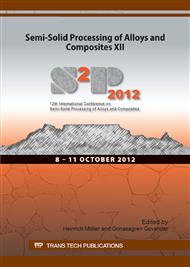p.365
p.373
p.379
p.386
p.392
p.398
p.404
p.410
p.415
Effect of Superheat on Melting Rate of EEM of Al Alloys during Stirring Using the RheoMetal Process
Abstract:
The RheoMetal process (previously called the Rapid S- and RSF- process) is a novel method to produce cost effective, high quality, semisolid slurries for component casting. The RheoMetal process uses an Enthalpy Exchange Material (EEM) as cooling agent to absorb heat and produce a slurry. Critical process parameters to create a slurry by robust melting of the EEM are alloy content, stirring speed, EEM to melt ratio, EEM temperature, EEM microstructural characteristics and melt superheat. In this paper, the melting sequence and melting rate of the EEM was studied experimentally. The effect of EEM composition, as well as superheat, on evolution of shape and dimension of the EEM during stirring was investigated. Initial material freezing onto the EEM was observed, followed by a stationary phase with subsequent gradual melting of the EEM. It was shown that the characteristics of freeze-on layer were strongly correlated to melt superheat, EEM temperature, as well as material composition, hence also has significant influence on the melting sequence.
Info:
Periodical:
Pages:
392-397
Citation:
Online since:
October 2012
Authors:
Price:
Сopyright:
© 2013 Trans Tech Publications Ltd. All Rights Reserved
Share:
Citation:


